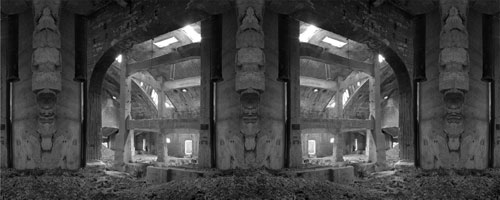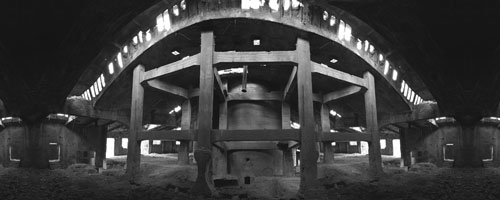

computer print 60 x 150 cm

computer print 60 x 150 cm

computer print 60 x 150 cm
The Palindrome - or versus recurrentes, or. Symmetry.
by photographs by Tomasz Mażewski
Mimetic art must naturally have to
do with one of three kinds of objects:
reality as it was or is (real reality),
reality of which one speaks of
or thinks (reality as it is thought to be),
or reality as it should be (ideal reality).
Aristotle: Poetics, XXV/10
do with one of three kinds of objects:
reality as it was or is (real reality),
reality of which one speaks of
or thinks (reality as it is thought to be),
or reality as it should be (ideal reality).
Aristotle: Poetics, XXV/10
The times of Aristotle and contemporary photography seem to be so dissimilar and irreconcilable that reaching for such an old text from which the epigraph to this essay has been borrowed seems to be an intellectual offence. However, it is not difficult to observe that many ideas from the works of the great philosopher are often quoted in various theoretical contexts, especially when the relation between art and reality becomes a dominant question. This state of affairs is a simple consequence of the universal and timeless significance of Aristotle's thought. In this context photography is undoubtedly a privileged medium, if we consider its relations with reality, which seems to justify the reference to the text of Poetics.
If we follow Władysław Tatarkiewicz and refer to The Great Theory of Beauty - Pythagorean in its origin - which included both sight and hearing, we should emphasize that ancient Greeks linked all symptoms of beauty with the perfection of structure which can be observed in the mutual proportions of their elements. Visible beauty was then called symmetry, or commensurability, while beauty that could be heard was called harmony, or consonance. In everyday use in ancient times symmetry more often than not meant proportion, although the sense of commensurability was given to the term by, for example, Euclides. In modern times the meaning of the term was modified, probably because it was given a specific denotation in the natural sciences - supported mainly by geometry, though one might add here that even Copernicus used it in the same sense as the Greeks did.
Symmetry conceived in this way was therefore an idealized warranty of the existence of beauty which gives pleasure to the viewer during the act of viewing - and I do not mean only sculptures or buildings, but also, more importantly - nature in all its visually accessible aspects. The ancients devised their canon of beauty or commensurability , or symmetry, inspired by the observation of nature.
If we follow Władysław Tatarkiewicz and refer to The Great Theory of Beauty - Pythagorean in its origin - which included both sight and hearing, we should emphasize that ancient Greeks linked all symptoms of beauty with the perfection of structure which can be observed in the mutual proportions of their elements. Visible beauty was then called symmetry, or commensurability, while beauty that could be heard was called harmony, or consonance. In everyday use in ancient times symmetry more often than not meant proportion, although the sense of commensurability was given to the term by, for example, Euclides. In modern times the meaning of the term was modified, probably because it was given a specific denotation in the natural sciences - supported mainly by geometry, though one might add here that even Copernicus used it in the same sense as the Greeks did.
Symmetry conceived in this way was therefore an idealized warranty of the existence of beauty which gives pleasure to the viewer during the act of viewing - and I do not mean only sculptures or buildings, but also, more importantly - nature in all its visually accessible aspects. The ancients devised their canon of beauty or commensurability , or symmetry, inspired by the observation of nature.
or evidence of the genius of the intellect?
Symmetry - let us formulate a provocative thesis - is rather a phenomenon that gives support to our organized perception of the surrounding world and is rather a key to its understanding than an immanent feature of its structure.
Let us look at the most obvious example taken from Nature - let us look at a tree. In the human scale of perception a slowly growing tree seems to be a totally symmetrical product of Nature. Vertically it reveals an axial rotational symmetry, horizontally speaking - its branches and the invisible system of roots also seem to be symmetrical. However, the conclusion of the above remarks ought to proclaim that they are extremely superficial. We know for a fact that we shall never find two tree-branches that are exactly the same, while their external similarity to roots is also a far-reaching simplification if we take into account their structure only - but then, even when we consider their function, it turns out that we find no more than differences! The above example forces us to consider the necessity of narrowing our point of view down to the position that takes into account merely the symmetry of shapes, i.e. the symmetry we can perceive visually by means of the analysis of views (vistas). Therefore, we should reject the notion of "symmetry of function" that can be grasped intellectually - in the case of a tree, such symmetry would mean that roots "collect" water, while leaves "breathe".
The "errors" of symmetry in the seemingly regular structure of the crystal web of metals, minerals and, moreover, all substances in whose structure we find all kinds of defects, make - in the micro-scale - the physical and chemical processes possible in the first place. Let us take a photographic example: the irregularity of the structure of the web of crystals of halogens of silver creates the so-called "sensitivity centres" whose existence allows - first of all - to expose, and then to develop the hidden image. In the macro-scale, homological irregularities in the structure of, let us say, geological layers, cause tectonic movement of the Earth's crust. The causes of cosmic disasters are similar.
Symmetry is, after all, a state of equilibrium, whose slight disturbances, not to mention complete disruption, cause in Nature - by force of the universal law of enthropy - the reduction of tensions, equalization of levels and standardization of states. Thus the cosmic tendency to achieve equilibrium - symmetry - is revealed, although, as practice shows and as, in many cases, science explains, symmetry practically does not exist! Science "looks for" symmetry in the structure of the world and sees it in natural processes - but does it really find it? We know of the examples of laevo-gyrate and dextro-gyrate crystals which definitely suggest its existence (it is interesting that some of them are man-made, as Nature produces only one of those two types of crystals), but we cannot find it on the lower level - the level of molecules of such structures. Even atoms lack symmetry because if we ignore the "dynamics of mobile electrons" their number is not always even and their localization in individual orbits is different. However, if we take into account a completely different standpoint, we cannot even begin to understand the theory of relativity without the notion of symmetry.
So does symmetry exist or does it not, even though it can be perceived in so many different forms? Ideal and unwavering symmetry undoubtedly exists only as a theoretical model in natural sciences. Symmetry in relation to a point, line, plane, mirror symmetry and rotational symmetry are but the most obvious of its possible variants in geometry. It can also be found in higher mathematics - here three kinds of symmetry as fundamental traits of Fourier's sequences are a good example. Intellectual exploitation of the question of symmetry resulted in the notion of anti-symmetry in mathematics, sliding symmetry in geometry and even false symmetry in crystallography.
From this perspective we can see a certain "intensification" of the feeling of the existence of symmetry as an objective idea. It is the result of the process of intellectualization for which natural sciences are responsible and which in consequence convinces us of the possibility of getting to know and to accept the category of symmetry only in terms of intelligibility, i.e. as a scientific abstraction existing only in the sphere of the intellect. Practice, not only of everyday eyewitness contact with the world, actually enables us only its passive perception and usually does not go any further. Speaking of such a visual impression we should, however, emphasize its superficiality. On the other hand, it also causes the stereotype of the universal presence of symmetry which we all succumb to. We are convinced that symmetry surrounds us and is present in all kinds of lifeless natural matter, especially - which in most cases is true - in the material results of the activity of man who in modern times, due to the civilizational development, has changed his environment so radically that it practically consists solely of unnatural objects, i.e. of artefacts or objects that came into being because man influenced natural processes and finally imposed symmetry on Nature (planted forests, regulated rivers etc.).
The smaller and more primitive the organism, the more perfect symmetry it reveals in its structure - here we usually give examples of protozoa or an earthworm; but the symmetry of bacteria is not so evident under the microscope. The symmetry of human organism seems equally obvious if we look at ourselves in the mirror - which we do every day. However, we know that such an impression is deceptive - it is enough to stand in front of the mirror sideways, not to mention confronting the reflection with our knowledge about the internal complexity of the structure of human bodily organs. Of course, this problem may be described and explained scientifically. In the first case we have to distinguish axial symmetry on a given plane (axis of the face, the collar-bone and the pelvis - there is symmetry here) from axial rotational symmetry in a given space (along the axis of the spine - no symmetry there), but on the other hand we must distinguish symmetry in relation to a line (a human being seen from the front - a vertical line: the nose- the belly-button) from the symmetry in relation to the plane of a mirror which is noticeable in any position of the model in front of the mirror as here there is always the symmetry of reflection. In the second case we can explain the asymmetry of our internal structure using our knowledge of the unusual evolution of mammals which forced quick "elongation" of our alimentary canal, quicker than the growth of the whole organism and leading in consequence to its internal de-symmetrization. It is interesting that it "did not bother" the forces of evolution or disturb "the natural order" which - naturally - should be "harmonious", or as the ancients would have it - "symmetrical".
Still, the existence of symmetry in the surrounding world seems unquestionable - in the world that we know for the most part thanks to the cognitive activity of our apparatus of visual perception. Nevertheless, it seems impossible to decide whether it is the symmetry of the structure of the elements of this world or their apperances, or if it is, perhaps, merely the symmetry in the eye of the beholder? Knowledge - or speaking in narrower terms, information from all the other senses does not provide us with impressions that would be homologous to visual symmetry. The obvious - in this context - duality of impressions, such as silence and its absence, coldness and warmth, etc, actually has nothing to do with the notion of symmetry.
The blunder of this kind of thinking which leads ad hoc to the "associational" treatment of the question of symmetry and the acknowledgment of its universality results from identifying symmetry with duality. Indeed, duality is one of the basic characteristics of symmetry, but it cannot replace it. However, its domination reduces other aspects of the question of symmetry because of duality's perceptional facility. It is hard not to give in to the power of fleeting visual impressions that fashion our behaviour in spite of the knowledge that our perception is shallow and rather "automatic", especially visual perception in which, moreover, we have to do with a phenomenon of the redundance of data.
The world around us provides us - we could say - with an excess of symmetry. It is easy to see today, especially from a historical perspective, especially one far removed in time. "Views" that surrounded man thousands of years ago did not "serve" symmetry as a rule. Until the construction of the Roman Via Appia there were no roads built in a straight line, while the roads that had been built before meandered among the hills and went around all natural barriers. Nature did not exhibit signs of any kind of order with the exception of the stochastic one. Chance, or. natural oder dominated. In contrast to nature, architecture had been an artificially created, organized spatial order since its beginnings. Mass production of architectural objects caused evident changes in the contents of the "views", as such objects introduced regularly reproduced ovals, right angles and - which seems natural and is most important, though often passes unnoticed - symmetry. However, if we wanted to take into account the quantitative proportions in the character of the "views" that man perceived not so very long ago, it would turn out that the naturality of stochastic "views" definitely dominated over "symmetrical"orders that were the result of civilizational changes. As usual, in the study of such historical phenomena it is difficult to indicate a concrete moment in time as the starting point of these changes. It seems that in our cultural environment the results of the fast growth of the cities at the end of the Middle Ages were most significant. This led to the changes in the "views" that surrounded man in those times. Geometrical order started to dominate and it was quite often also a symmetrical order. We can hardly fail to notice it, standing in the naves of medieval churches, and we cannot help but reflect on this kind of visual impressions inside a Gothic cathedral. The general urbanization of the environment sealed the domination of symmetrical "views" over the hitherto more frequent stochastic ones. Some premises leading to the verification of the above thesis may be found in the rediscovery of perspective in Renaissance painting - of the geometrical perspective, that is, leading to one point on the horizon, a perspective one of the most significant features of which is symmetry. How easy it was to see it inside a cathedral - and how difficult it is to see outdoors! Today geometrical perspective is something so obvious that we take it for granted standing on a city street, in a park (which does not have to be classicistic) or even in the forest whose regularity results from the fact that it had been planted by man. In conclusion, it could be said that the universal asymmetry of views and its consequences - the absence of a functioning "mechanism of seeing symmetry" were natural aspects of human perception before the breaktrough I have described above; while the symmetry that dominates today is a civilizational factor - a kind of modification that appeared and was strengthened in our perception of "views" along with the development of architecture and urbanization.
The facility of moving to "the stage of the symmetry of seeing" is the result of the adequacy of symmetry as a tool and method of description and introducing order in the world. The logic of symmetry gives us the feeling of completeness that rationalizes the existence of everything in the world around us and arranges the left in opposition to the right, the back in opposition to the front, the top in the opposition to the bottom, creating the sense of equilibrium and the awareness of harmony. Symmetry for human intellect is a method which tames the incomprehensible chaos of the external world, it is a means of introducing order into the data about this world and a means of founding an organized system of internal relations between them. It warrants all equivalence, from the simple scale mechanism, an instrument used to balance equally heavy objects, to the equation E=mc2.
In this context it comes as no surprise that the idea of symmetry has penetrated the results of all kinds of human activity that introduces civilizational changes and produces cultural facts. So, if symmetry is so ubiquitous, up to the point that wherever the world does not reveal it, the intellect creates it, if it is universally noticed and universally understood and accepted as an obvious fact - then it is but a stereotype. This is the basis for the proper understanding of the observation ascribed to Witkacy: that symmetry is the aesthetics of fools. in spite of the fact that symmetry has always existed in art.
Symmetry as a rule of the construction of pictorial representation, i.e. conceived in a contemporary way, is over five thousand years old! Authors of Sumerian bas-reliefs from around 2500 B.C., and also Babylonian artists, produced examples of - curiously - not mirror, but rotational (spatial) symmetry, which is the effect of the rotation of the plane of the picture in space around the centrally located vertical axis. This kind of symmetry seems natural if we remember that it is rooted in pottery, as pottery creates solids of revolution. However, in pictorial representations we find much more examples of mirror symmetry, although in many ancient and later works it is not literally "mirror" symmetry, i.e. the left part of the picture is not immediately identical with the right.
One of the most famous examples of mirror symmetry is the Byzanthine paten with the picture of the Eucharist in which a double figure of Christ is centrally poised among His disciples: Jesus simultaneously gives bread to those sitting on His right and pours wine to those sitting on His left. This example heralds the conventionality of pictorial representations in-the-making, based on the domination of the rule of formal construction (symmetry) over the rule of emulating nature. However, this second rule finally prevailed in the history of contemporary art in the world of Christian civilization. Nevertheless, it is interesting that we could find two-headed birds or animals, especially in heraldry, even in the 20th century, for example in imperial seals and escutcheons.
However, most paintings known from the history of contemporary art are usually composed in asymmetric ways; even portraits in which the vertical axis of symmetry of the painting - not of the portrait - goes through the eye (the left or the right one, no fixed rules here), not through the nose, which would seem obvious and which most viewers involuntarily assume while looking at any portrait. This specific play with our sense of symmetry might be seen in the works of almost every portrait-painter, from Da Vinci to Rubens and Cézanne.
Art and symmetry in the multitude of its forms have been - one might say - condemned to keep each other company for ever and since long ago. Architecture - here the correspondence is naturally obvious; sculpture - here, on the other hand, especially in classical sculpture, the analogy with the symmetry of the human body seems to be most important; painting - here we have to do with the largest number of dissimilarities, but in graphic art. it is enough to notice that in the printing process the axis of symmetry actually goes along each edge of the matrix, where it touches the paper. Indeed, but this is "the symmetry of the process" of the picture's production - a mirror symmetry, though not "symmetry in the picture". In this context we cannot help mentioning decalcomania, employed on a mass scale in 18th century England as a method of mechanical transfer of pictures in the process of adorning pottery which later, in the 1930s, was readily used due its automatic nature by the surrealists - mainly by
O. Dominguez.
Wherever art adjoins usefulness or adopts decorative functions as most important, symmetry is most often the primary rule that organizes all aesthetic orders. Classicistic furniture, art nouveau gates or Bauhaus earthenware are spheres in which we might find paradoxical examples in which the leading role of symmetry obviously collides with functionalism, like in the case of a coffee-pot with two spouts.
All of the above remarks have to do most of all with symmetry whose various symptoms man perceives visually. Is it natural, i.e. does it exist as the feature of the structure of different forms of the world around us, or is it "artificially" produced by man, i.e. is it always a physical phenomenon which possesses its own material foundation of existence in all the products of art and technology?
The above-mentioned duality as a rational and practically verifiable method of the description of the world lets symmetry also "govern" the intellect and take possession of the organization of data supplied by other senses, which leads to the search for "pairs" or elements that can be "coupled" and results in the specific satisfaction we feel at the moment of finding them.
Language - due to a long and unimaginably complex evolution, the most accurate system of communication - is a marvellous product of the intellect and contains many kinds of logical symmetry. Its nouns name "oppositions" - objects and phenomena - and a similar analogy may be found in the naming of acts and processes, though the idea of logical symmetry is most clear in the system of the description of features and qualities of the elements of the world around us. Adjectives of quality and relation or characterization and subjectivity, as well as adverbs, are the names of those features and qualities - which the human perception apparatus distinguishes, perceives as clearly different and finally classifies them by means of the intellect. Neo-Kantian interpretation of the nature of language, as something that conditions the existence of things and phenomena in social consciousness by means of the obligation of naming them, confirms the above hypothesis. A rationally justified dualism of forms of the linguistic description of the world on the level of words seems obvious in this context.
The level of utterance is also not free from dualism/symmetry! Symptoms of this phenomenon should be recognized in the rhythmical organization (of accent consonance) of an utterance, as well as in all rhyming constructions. Indeed, in both of these cases we have to do with the recurrence of identical sound elements or with "the symmetry of points on the axis of the duration" of an utterance. However, we should remark that these arrangements are elements of surplus order in the text which moves the function of language from the field of information to the field of aesthetic influence, i.e. of literature as the art of language. It is hard to refrain from mentioning visual poetry here, which encloses literary contents in a specifically organized graphic form. In a multitude of historical examples of visual poetry we encounter symmetrical systems produced by Theocritus, and later by many others, including Theo van Doesburg. But in this case we are rather returning to pictures.
An interesting example of linguistic symmetry is the form of those probably unintendedly produced words whose spelling and phonetic identity is preserved when they are read or uttered both ways, normally and backwards. In the Polish language the word kajak [kayak] is a famous example. Palindromes, as such words are called, are not frequent, although they exist in many languages.
An undoubtedly logical symmetry may be found in a literary genre called cancrine which has been known and practised since antiquity. The charm of single sentences or even longer texts which can be read identically both ways has been exploited for centuries and in some cases magical powers have been ascribed to them. Cancrines in Polish were written by Kochanowski and the master of the genre was Tuwim.
in a photographic image?
Stefan Czyżewski, Łódź, March 2006
Translation by Maciej Świerkocki
Translation by Maciej Świerkocki

computer print 60 x 150 cm

computer print 60 x 150 cm

computer print 60 x 150 cm

computer print 60 x 150 cm
Copyright ©2006 Galeria FF ŁDK, Tomasz Mażewski, Stefan Czyżewski.
